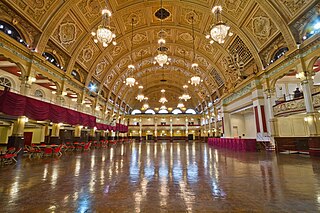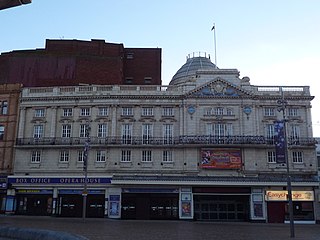
The Royal Pavilion, and surrounding gardens, also known as the Brighton Pavilion, is a Grade I listed former royal residence located in Brighton, England. Beginning in 1787, it was built in three stages as a seaside retreat for George, Prince of Wales, who became the Prince Regent in 1811, and King George IV in 1820. It is built in the Indo-Saracenic style prevalent in India for most of the 19th century. The current appearance of the Pavilion, with its domes and minarets, is the work of architect John Nash, who extended the building starting in 1815. George IV's successors William IV and Victoria also used the Pavilion, but Queen Victoria decided that Osborne House should be the royal seaside retreat, and the Pavilion was sold to the city of Brighton in 1850.

Blackpool is a seaside resort town in Lancashire, England. It is located on the Irish Sea coast of the Fylde peninsula, approximately 27 miles (43 km) north of Liverpool and 14 miles (23 km) west of Preston. It is the main settlement in the borough of the same name. The population of Blackpool at the 2021 census was 141,000, a drop of 1,100 from the 2011 census.

Avenham Park is a Grade II* listed public park in Avenham, close to the centre of Preston in Lancashire in the northwest of England, and managed by Preston City Council.
Horace Finch was an English pianist and organist.

Southport Pier is a pleasure pier in Southport, Merseyside, England. Opened in August 1860, it is the oldest iron pier in the country. Its length of 1,108 m (3,635 ft) makes it the second-longest in Great Britain, after Southend Pier. Although at one time spanning 1,340 m (4,380 ft), a succession of storms and fires during the late 19th and early 20th centuries reduced its length to that of the present day.
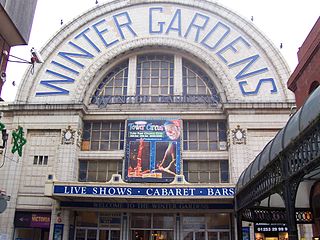
The Winter Gardens is a large entertainment complex in Blackpool, Lancashire, England, which includes a theatre, ballroom and conference facilities. Opened in 1878, it is a Grade II* listed building, operated by Blackpool Entertainment Company Limited on behalf of Blackpool Council, which purchased the property from Leisure Parcs Ltd as part of a £40 million deal in 2010.
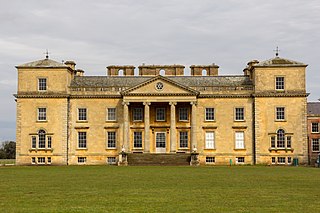
Croome Court is a mid-18th-century Neo-Palladian mansion surrounded by extensive landscaped parkland at Croome D'Abitot, near Upton-upon-Severn in south Worcestershire, England. The mansion and park were designed by Lancelot "Capability" Brown for the 6th Earl of Coventry, and they were Brown's first landscape design and first major architectural project. Some of the mansion's rooms were designed by Robert Adam. St Mary Magdalene's Church, Croome D'Abitot that sits within the grounds of the park is now owned and cared for by the Churches Conservation Trust.

Victoria Pier is a pier in the seaside resort of Colwyn Bay, Wales. The pier fell into disrepair and much of it was demolished, it was reopened in 2021 with a reduced length. Visitors can access the pier and see the bay along its length. Some of the original metalwork remains and retains the legal status of a grade-II listed structure.

Morecambe is a seaside town and civil parish in the City of Lancaster district in Lancashire, England. It is located in Morecambe Bay on the Irish Sea.

The Pavilion Theatre and Ballroom is a concert hall in Bournemouth. It opened in 1929 and has been redesigned several times since.
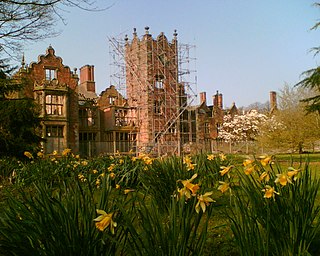
Bank Hall is a Jacobean mansion in Bretherton, Lancashire, England. It is a Grade II* listed building and is at the centre of a private estate, surrounded by parkland. The hall was built on the site of an older house in 1608 by the Banastres who were lords of the manor. The hall was extended during the 18th and 19th centuries. Extensions were built for George Anthony Legh Keck in 1832–1833, to the design of the architect George Webster.

The Southport Winter Gardens was a Victorian entertainment complex in the town of Southport, Merseyside. The original winter gardens comprised a theatre, opera house, aquarium, a small zoo, conservatory, promenades and halls situated under the grand glass domes.
The Alhambra was an entertainment complex in Blackpool, Lancashire, England, from 1899 to 1903. A financial disaster, the building was bought by the Blackpool Tower Company and reopened in 1904 as the Palace. The building was demolished in 1961 to make way for Lewis's department store.

Maxwell and Tuke was an architectural practice in Northwest England, founded in 1857 by James Maxwell in Bury. In 1865 Maxwell was joined in the practice by Charles Tuke, who became a partner two years later. The practice moved its main office to Manchester in 1884. Frank, son of James Maxwell, joined the practice in the later 1880s and became a partner. The two senior partners both died in 1893, and Frank Maxwell continued the practice, maintaining its name as Maxwell and Tuke.

The Alhambra is a theatre situated on the West End promenade in the English seaside resort of Morecambe, Lancashire. Opened in 1901 as the Alhambra Palace, it took its name, though not its style, from the famous Moorish original in Granada, Spain. The building was in continuous use, with a range of entertainment and social uses, until 1970 when a fire gutted the interior. Following extensive refurbishment the theatre reopened in 1973 as The Inn on the Bay before renaming itself The Carleton Club, becoming a major events venue and one of the great Northern soul dance clubs. After closing in 2016, it reopened it the same year as a multi-purpose venue with capacity up to 1,100. The theatre was the location where Laurence Olivier shot his iconic 1960 film version of John Osborne’s The Entertainer.
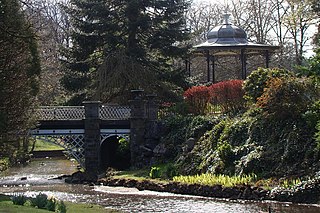
Buxton Pavilion Gardens is a Victorian landscaped public park in the spa town of Buxton in Derbyshire. The River Wye flows through the gardens, which are a Grade II* listed public park of Special Historic Interest.

Central Pier was one of two piers in Morecambe, Lancashire, England. Built during the late 1860s, it was 912 feet (278 m) long and featured a large pier head served by steamboats. Two significant fires occurred during its lifetime, one in 1933 destroying the pavilion then dubbed the "Taj Mahal of the North", and another in 1991, the latter which condemned the pier as unsafe and demolition took place the following year in 1992.












